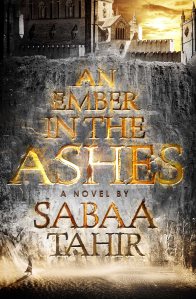 Teen Book Crew Review: An Ember in the Ashes
Teen Book Crew Review: An Ember in the Ashes
by Natalie Silva
Oh Skies, where do I begin? … First of all congratulations Sabaa Tahir on a splendid debut novel! Seriously, my mind is still thoroughly blown away by this book. An Ember In The Ashes is a what I consider to be a fantasy romance adventure novel that surrounds itself around a new graduate of Blackcliff training camp and a rebel slave girl who just so happened to become intertwined with each other either because of coincidence or fate. Everything that I love and find paramount in a story is present within An Ember In The Ashes there is action, drama, romance, suspense and a bit of a mystery to keep the reader guessing. Even though this novel surrounds the destiny and fate of two very well crafted and paralleled characters.
I wouldn’t consider it foreshadowing necessarily the way the future was incorporated into the present. It’s much more obvious and blatant like in The Book Thief where the narrator outright tells you the ending on page 100, but how and why the ending happens is surrounded in a nebulous of ambiguous immortal beings and characters so caught up in events that they can’t see what a less invested reader would. It is sort of like dramatic irony, but still with an element of mystery making this book extremely addictive. Seriously I set a new personal record for how quickly I read this book, which was three days. The concept and world were so well constructed and excellently illustrated that I could smell the rotting catacombs, hear the drums banging in the distance and even feel the hot knife against my own skin. It was refreshing to so thoroughly experience a novel and not just read it, especially when exploring this magical realm which was created, From the somber prison of Blackcliff to the sensual illumination of the moon festival down into the market which appropriately shifted depend on who is narrating.
Now, I typically do not prefer novels with dueling perspectives because one character is always better in the sense of screen time, distinctive style and construction, making one of the perspectives a secondary character instead of both sharing the role of protagonist. Except in this story where Elias and Laia are two very different characters that are both the center of their own story and also the overarching one. This worked so well especially with the preproposed question of “who was truly enslaved?” A question that I’m still trying to answer, personally I view Laia as free and Elias as the slave, but depending on what section is cited within the text the answer changes. There is no right or wrong answer, since it is a point left completely open to interpretation; what makes someone enslaved? Does enslavement only exist between people, or can it be a moral obligation or fate? Who knows, but that is something which really should be considered throughout the entire novel and applied to all characters.
Writing of characters, oh my skies I love them! To sum them all up as complex, intelligent and emotional beings wouldn’t be sufficient enough. Everyone was so invested in their own agenda that when they were the focus, they were the main character, even if their point of view wasn’t the narrator’s, that’s just how strong and present they all were. So let’s get down to them! Elias is a bastard who can kick butt and puts others before himself. He’s sort of like your best friend only very well armed and internally crushed, which sounds stereotypical and standard, but that’s the jist. Although that in no way does justice to his character, since Elias has a lot of respect and is very thoughtful of other people, everyone comes before him and he views all life as precious. Even a little Slave girl such as Laia who is battered, but still stands tall since she cannot be broken is valuable. Laia is debatably selfish with how she does put herself in front of others, making for a great juxtaposition as Elias and Laia develop. They share more similarities than differences, although the variations between them speak a lot about class, moral codes and motivations. Hint: Pay attention to how they influence each other, especially after Laia learns Elais’ true name and tribal name. (Personally I think she should have used his tribal name as opposed to his true name). Now there are at least three more characters I could talk about, but I will only mention Elias’ best friend Aquilla who is quite intentionally the opposite to Laia and in some cases is Elias’ double standard. With Aquilla’s fair skin and silver hair to Laia’s dark skin and dark hair also Aquilla’s fabled strength and Laia’s weakness when it’s typically the opposite. (Not exactly a spoiler, but sorry anyway) Which at first made my impressions of Aquilla to be rather negative and it wasn’t until I had the epiphany about how she and Laia are dramatic foils that also complement Elias’ internal struggle surrounding freedom. Overall, characters are paramount in a story and these characters reached the top of the mountain (even if one is scared of heights). They brought the story to life and I absolutely loved them all.
Now, for my final verdict, where I highly recommend this book for the amazing lore, corrupt totalitarian dictatorship, writing, characters and will be readily awaiting the sequel that is bound to come. Even though I am inherently angry because I know I will have to wait an extra-long time for it because technically the novel has yet to be released. But I will be patient!
